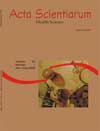Experimental model of ventral hernia in rats
Abstract
The behavior of the defect provoked in the abdominal wall, with the purpose of establishing a model of ventral hernia in rats, was the objective of this study. Hundred and thirteen rats weighting from 230 to 260g and 3 months fase were distributed in two groups. In group I, the animals were submitted to standard incision in line alba. In group II, the animals were submitted to standard muscle-aponeurotic resection. In both groups the animals were redistributed in three subgroups (A, B and C), considering observation time of 15, 30 and 45 days. Dimensions, volume, adhesions and histological aspects of fragments of hernias sacs were analyzed in developed hernias by mean of hematoxylin-eosin technique. Data were submitted to statistical analysis. In subgroups I A, I B and I C, 93,3%, 45% and 53,3%, respectively , and in subgroups II A, II B and II C, 66,7%, 35% and 47,7%, respectively of the animals developed hernias. In both groups the measures of the greater dimensions of the hernial ring surpassed 3 centimeters and the volumes 3 ml, classifying them as large hernias. Adherences were found in almost all the animals. The postoperative mortality rate was 8% in group I and 18% in group II, being evisceration the death cause. The histological study showed maturation of hernia sac pat 30 days of observation, in both groups. In agreement with the obtained results, incision (Group I) was more appropriate to simulate ventral hernia in rats, although there was not hernia development in all the animals.Downloads
Download data is not yet available.
Published
2008-05-06
How to Cite
Mardegam, M. J., Bandeira, C. O. P., Novo, N. F., Juliano, Y., Amado, C. A. B., & Fagundes, D. J. (2008). Experimental model of ventral hernia in rats. Acta Scientiarum. Health Sciences, 23, 683-689. https://doi.org/10.4025/actascihealthsci.v23i0.2909
Issue
Section
Health Sciences
DECLARATION OF ORIGINALITY AND COPYRIGHTS
I Declare that current article is original and has not been submitted for publication, in part or in whole, to any other national or international journal.
The copyrights belong exclusively to the authors. Published content is licensed under Creative Commons Attribution 4.0 (CC BY 4.0) guidelines, which allows sharing (copy and distribution of the material in any medium or format) and adaptation (remix, transform, and build upon the material) for any purpose, even commercially, under the terms of attribution.
Read this link for further information on how to use CC BY 4.0 properly.























5.png)







